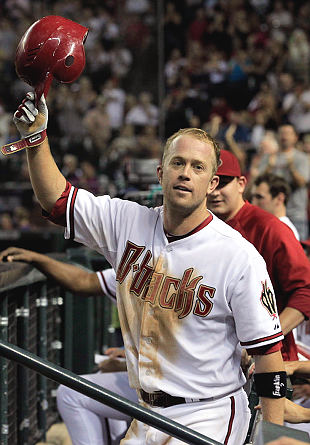Aaron Hill of the Arizona Diamondbacks hit for the cycle Monday night, putting himself in the record book and capping off his contributions to a 7-1 victory against Seattle with a three-run home run in the seventh inning. It's the fifth cycle in D-backs history, a franchise that's only 14-plus seasons old. For comparison's sake, the White Sox — established in 1901 — also have five cycles in their history. The Marlins (1993) and Padres (1969) are the only two franchises to never have a batter hit for the cycle. At the other end of the spectrum, the Giants franchise has 25 cycles.
Only the Rockies, with six, and Athletics, with five, have as many cycles as the D-backs since Luis Gonzalez hit the first for them in 2000.
On June 5, Hill found himself in a similar position against the Rockies, but failed to hit a double to complete a cycle. This time, he got what he needed:
''You just have to take a deep breath,'' Hill said. ''It's something you can easily get excited about and try to do a little too much. It's something where, you've been here before, just get up there, see some pitches and put a good swing on it.''
Hitting for the cycle requires excellence and precision, but also a great deal of luck.
 To do it, a batter must hit a single, double, triple and home run in one game. What if you hit two home runs but no singles? No cycle for you, buddy. So hitting for the cycle also requires a certain amount of restraint. Taking an extra base might disqualify you. That's probably why the cycle doesn't get as much respect as other feats, even though it's about as frequent as a no-hitter. (Hill's is the 293rd cycle in history; there have been 272 no-hitters.)
To do it, a batter must hit a single, double, triple and home run in one game. What if you hit two home runs but no singles? No cycle for you, buddy. So hitting for the cycle also requires a certain amount of restraint. Taking an extra base might disqualify you. That's probably why the cycle doesn't get as much respect as other feats, even though it's about as frequent as a no-hitter. (Hill's is the 293rd cycle in history; there have been 272 no-hitters.)
Scott Hairston of the Mets also hit for the cycle this season, and they've become more frequent in recent seasons. There have been 16 cycles since the start of the 2009 season and 54 since the turn of the century. For contrast, players in the 1960s hit 14 cycles total. And in the '50s? Eleven.
In addition to luck, ballpark size plays a factor. Parks such as Chase Field and Coors Field give up a lot of triples — the rarest kind of hit.
Love baseball? Even like it a little?
Follow @AnswerDave, @bigleaguestew, @KevinKaduk on Twitter,
along with the BLS Facebook page!
No comments:
Post a Comment